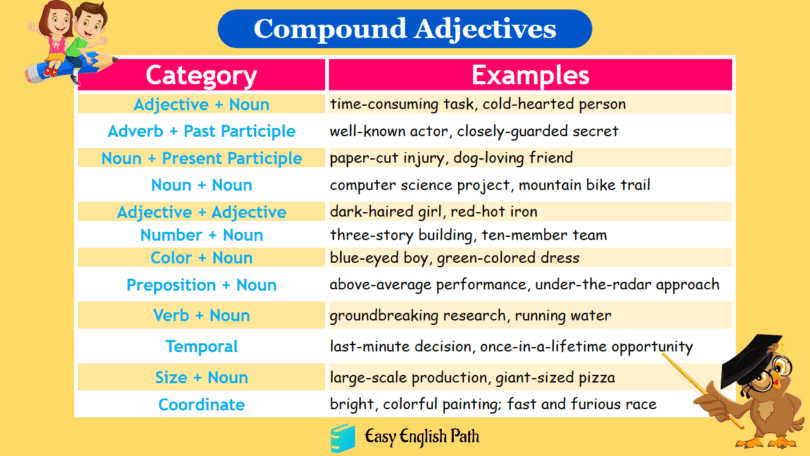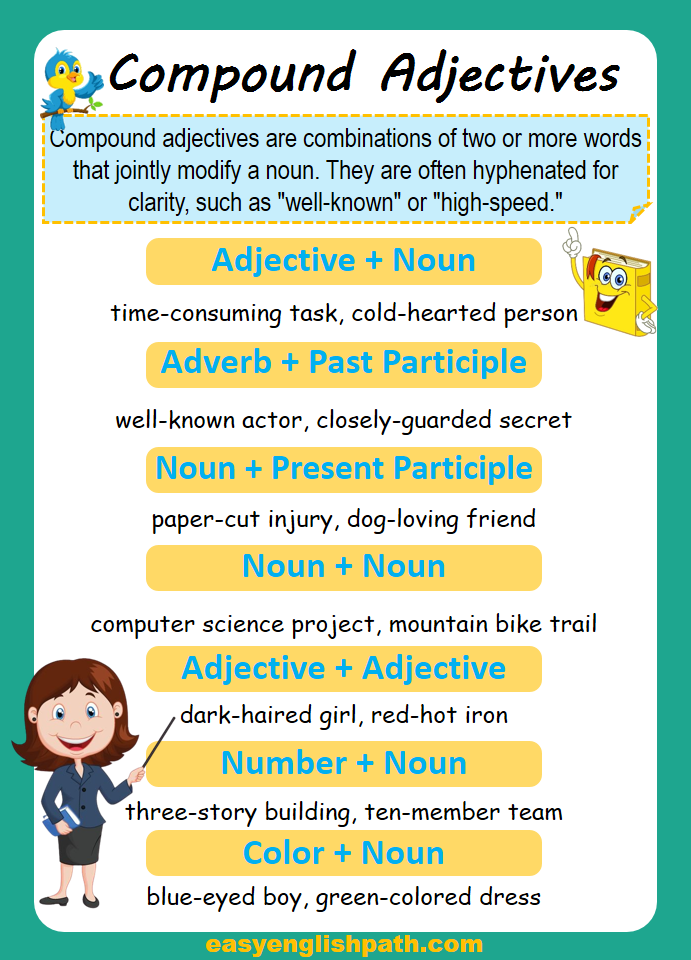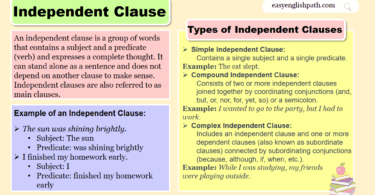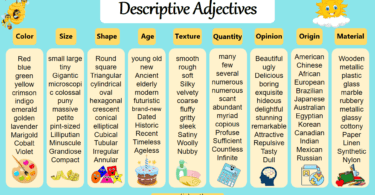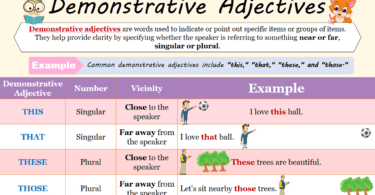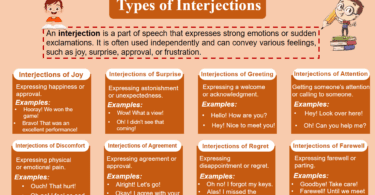Compound adjectives are adjectives made up of two or more words that work together to describe a noun. They help add detail and make descriptions more specific. These adjectives are often linked with a hyphen to ensure clarity and prevent confusion.
By combining words, compound adjectives create a single idea that provides more precise information. They are commonly used in everyday language, writing, and professional communication to make descriptions clearer and more effective.
What is a Compound Adjective?
A compound adjective is made up of two or more words that work together to describe a noun. These words are often connected by hyphens to show they are a single unit describing the noun. For example, in a well-known author, well-known is a compound adjective describing the author.
Examples:
- The beach was sun-soaked.
- His presentation was fast-paced.
- The couple was well-dressed.
Compound Adjectives Structure
1. Adjective + Noun
The noun functions as an adjective to give more detail.
- Full-length mirror
- High-quality material
2. Adverb + Past Participle
The adverb changes the meaning of the past participle.
- Well-known author
- Highly respected professor
3. Noun + Present Participle (-ing)
The noun explains what the present participle is doing.
- Time-saving method
- Record-breaking performance
4. Noun + Noun
Two nouns combine to describe another noun.
- Ice-cold drink
- World-class athlete
5. Adjective + Adjective
Two adjectives together create a new meaning.
- Blue-green eyes
- Bitter-sweet moment
6. Number + Noun
A number is used to describe the noun, usually with a hyphen.
- Ten-year-old boy
- Two-hour movie
7. Color + Noun
A color is combined with a noun for vivid description.
- Snow-white dress
- Jet-black car
Compound Adjectives vs. Compound Nouns
| Feature | Compound Adjectives | Compound Nouns |
|---|---|---|
| Definition | Two or more words that work together to describe a noun | Two or more words that form a noun together |
| Function | Modifies a noun | Acts as a noun itself |
| Hyphen Usage | Often hyphenated when before a noun (e.g., well-known author) | Usually written as one word, separate words, or hyphenated (e.g., toothbrush, ice cream, mother-in-law) |
| Examples | High-speed train, ten-year-old boy, world-famous chef | Football, newspaper, swimming pool |
| Position in a Sentence | Comes before the noun it describes | Can be the subject or object of a sentence |
When Should we use Hyphen?
We use hyphens in compound adjectives when the words come before the noun they are describing.
1. Before the Noun:
Use a hyphen when the compound adjective comes directly before the noun.
- A well-known author.
2. Avoid Ambiguity:
Use a hyphen to avoid confusion or ambiguity.
- A small-business owner vs. A small business owner
3. With Numbers and Fractions:
Use a hyphen when numbers or fractions are part of the compound adjective.
- A ten-year-old child or A thirds majority.
4. Adverbs Not Ending in -ly:
Use a hyphen with compound adjectives formed from adverbs that do not end in -ly.
- A well-known fact but A highly regarded scientist (no hyphen with -ly adverbs).
5. Part-time and High-profile:
Use a hyphen with common compound adjectives like part-time and high-profile.
- A part-time job or A high-profile case.
However, when the compound adjective comes after the noun, the hyphen is usually not needed.
- The author is well known.
Comparative Adjectives vs Superlative Adjectives
1.Comparative Adjectives
Comparative adjectives are used to compare differences between two objects. They typically end in “-er” or are preceded by “more” for longer adjectives.
- Tall → Taller
- Beautiful → More Beautiful
- Expensive → More Expensive
2. Superlative Adjectives
Superlative adjectives are used to describe an object that is at the upper or lower limit of a quality. They typically end in “-est” or are preceded by “most” for longer adjectives.
- Tall → Tallest
- Fast → Fastest
- Beautiful → Most Beautiful
- Expensive → Most Expensive
Compound Adjectives Rules
1. Use a Hyphen for Clarity
When a compound adjective comes before a noun, use a hyphen to avoid confusion. This helps in making the meaning clear.
- Well-known author, high-speed train
2. No Hyphen When After the Noun
If the compound adjective appears after the noun, the hyphen is not needed. The words remain separate.
- The author is well known.
3. Don’t Hyphenate Adverbs Ending in -ly
Adverbs ending in -ly should not be hyphenated when combined with an adjective or past participle.
- Beautifully designed dress (not beautifully-designed dress)
4. Use a Hyphen with Numbers and Fractions
Numbers and fractions in compound adjectives require a hyphen to link them together.
- Ten-year-old boy, three-fourths full
5. Maintain Hyphens in Fixed Expressions
Certain compound adjectives remain hyphenated regardless of position in a sentence.
- State-of-the-art technology, all-time favorite
Compound Adjectives Examples
- The cat is short-haired.
- It’s a high-tech gadget.
- She wore a red-dress.
- The cake was chocolate-covered.
- We took a last-minute trip.
- The car has four-wheel drive.
- He’s a well-known actor.
- It’s a three-story building.
- The cake is vanilla-flavored.
- The room has a low-ceiling.
Common Mistakes with Compound Adjectives
1. Forgetting the Hyphen Before a Noun
❌ A well known author
✅ A well-known author
2. Using a Hyphen After the Noun When Not Needed
❌ The author is well-known.
✅ The author is well known.
3. Hyphenating Adverbs Ending in -ly
❌ A beautifully-designed dress
✅ A beautifully designed dress
4. Not Using a Hyphen with Numbers
❌ A ten year old boy
✅ A ten-year-old boy
5. Separating Fixed Expressions
❌ State of the art technology
✅ State-of-the-art technology
FAQs About Compound Adjectives
1. What is a compound adjective?
A compound adjective is two or more words joined together to describe a noun.
2. When should I use a hyphen in compound adjectives?
Use a hyphen when the compound adjective comes before the noun.
3. Do I always need a hyphen?
No, if the adjective comes after the noun, the hyphen is usually not needed.
4. Should I hyphenate adverbs ending in -ly?
No, adverbs ending in -ly should not be hyphenated.
5. Are numbers in compound adjectives hyphenated?
Yes, numbers before a noun (e.g., ten-year-old boy) should be hyphenated.
You May Also Like this

